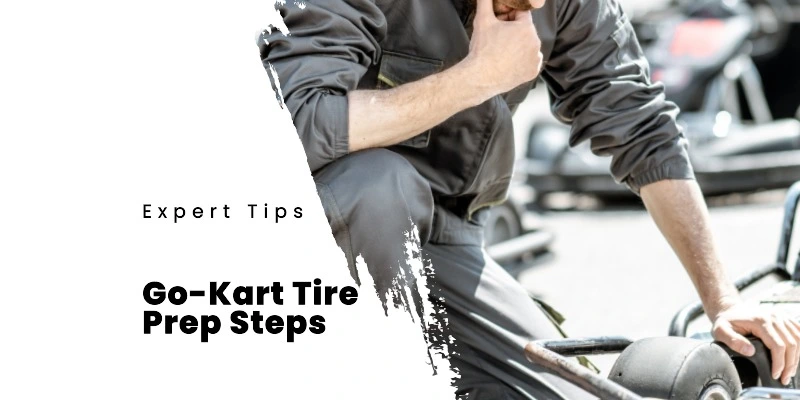Go-Kart racing is an exhilarating sport where every tenth of a second counts, making tire prep for go-kart racing a crucial factor in determining your performance. This article will delve into the ins and outs of go-kart tire prep, discussing different surfaces, track conditions, and karting rules and regulations, with expert tips on applying tire prep to ensure top performance on the track.
Get ready to enhance your go-kart racing experience by learning how to properly prep your tires and gain the competitive edge you need.
Understanding Track Conditions
Before starting the tire prep process, you must understand the track conditions you’ll be racing on. The type of track and its surface will play a significant role in how you prep your go-kart tires. Asphalt or dirt, every surface requires a different approach to ensure optimum performance.
For example, on asphalt tracks, you may need a specific tire compound that provides a better grip for that surface type. Dirt surfaces, on the other hand, may require a more aggressive tread pattern to maintain traction. You should also consider factors like weather and temperature, as these can influence the track conditions and affect the performance of your tires.
Remember that even small changes in track conditions can result in substantial differences in lap times. Therefore, investing time in understanding and adapting to track conditions is crucial for maximizing your go-kart’s performance.
How To Apply Tire Prep for Go-Kart Racing
Follow this step-by-step guide to tire prep your go-kart for top performance:
1. Identify How Many Applications You Need
Depending on the condition of your tires and the type of track you’ll be racing on, you might need one or more applications of tire prep formula. Read the instructions on your product, and calculate the required number of applications.
As a general rule of thumb, new tires may require a thicker layer of tire prep formula, while older tires may require less or even skip tire prep altogether. Remember that each tire’s needs will vary, so assessing its current state and following the product’s recommendations closely is crucial.
2. Place Your Kart on a Stand
Using a go-kart stand is crucial for easy access to your tires and ensuring an even application of tire prep. A go-kart stands not only makes your tires more accessible but also prevents them from getting wet or coming into contact with dirt or debris while you work on them.
Ensure all four tires are off the ground and the areas you’ll apply tire prep to are easily accessible. This will make the process smoother and help you achieve a more uniform application, resulting in better performance.
3. Scuff Your Go-Kart Tires
Scuffing your tires with sandpaper or a belt sander improves the tire grip and helps the tire prep formula adhere better. This is particularly important when dealing with new tires or heavily worn ones. Scuffing the outer tire surface helps create a rough texture, allowing the tire prep formula to bond more effectively with the rubber.
Start using lower-grit sandpaper, such as 80-grit, to remove any surface impurities or uneven spots. Then, switch to a higher-grit sandpaper, like 150-grit, to create a smoother surface. Make sure to scuff the entire tire surface evenly, paying close attention to the edges and corners.
4. Apply The Tire Prep Formula
Tire prep is a crucial aspect of go-kart racing, ensuring optimal grip and performance. There are three methods for applying tire prep: spray, brush, and roller. Each method has advantages and disadvantages, with sprays being the quickest but possibly least even and brushes or rollers providing better control and precision. Gloves and protective eyewear are essential during the application process to avoid irritation.
Before applying the tire prep formula, remove any rubber residue from the go-kart tires using a dry cloth or brush. Read the tire prep container instructions for the specific formula application, or follow a general guideline if using a homemade mixture.
The table below demonstrates the amount of tire prep formula to apply based on the track’s grip level:
| Track Grip Level | Outer Tire | Inner Tire |
|---|---|---|
| Low Bite | 4 ounces | 3 ounces |
| Medium Bite | 4 ounces | 3 ounces |
| High Bite | 2 ounces | 1 ounce |
The outer tire requires more formula due to increased contact and wear during cornering. Thicker applications are needed for tracks with lower grip levels, providing the extra traction necessary. You can apply the full tire prep amount in one go or divide it into multiple thinner applications. Remember to leave at least 48 hours before the race begins for the last application to dry.
By thoroughly preparing your go-kart tires using the appropriate tire prep formula and method, you’ll maximize performance and grip, potentially making the difference between victory and defeat.
5. Let the Formula Dry
Allow the formula to dry properly. This usually takes at least 48 hours. Keep your tires away from moisture or any surface that might come into contact with them. Proper drying time ensures the tire prep formula adheres to the tires and works effectively during the race.
During the drying process, storing your tires in a dry, cool, and well-ventilated area is essential to prevent the tire prep from becoming contaminated or affected by moisture or heat. You may also consider wrapping the tires in a bag or plastic wrap to protect them from dust and debris.
6. Mount the Tires on the Rims
After the tire prep has dried, mount the tires on the rims, ensuring they are seated correctly and securely. Carefully check the tire bead for any signs of damage or irregularities and address any issues before mounting the tires.
Ensure that the tire and rim surfaces are clean and free of debris or lubricants, as these can compromise the integrity of the tire’s seal. If necessary, use a tire mounting paste to facilitate the process and avoid damage to the tire bead.
7. Inflate the Tires to the Correct Pressure
Follow the guidelines for optimal air pressure for your go-kart tires. The correct pressure will vary depending on track conditions, tire type, and kart weight. Inflate the tires to the recommended pressure for your racing conditions, ensuring they provide the best grip and performance.
Remember that tire pressure can change as the tires heat up during the race, so monitoring the pressure throughout the event and making adjustments as needed is essential.
Tire Prep for Go-Kart Racing on Different Surfaces
Tire prep is not a one-size-fits-all process; different surfaces require unique approaches. For example, on asphalt tracks, you may need to focus on achieving a better grip with a specific tire compound, while on dirt tracks, a more aggressive tread pattern might be necessary.
It’s essential to research the specific track you’ll be racing on and adjust your tire prep strategy accordingly. Weather, temperature, and track composition can impact your tire prep process and overall performance.
Competition Rules and Regulations
Before applying any tire prep formula, checking the competition rules and regulations is crucial. Some racing events may restrict tire prep formulas, and using prohibited substances can result in disqualification or other penalties.
To determine whether a specific tire prep formula is allowed, consult the race regulations or check directly with the organizer. It’s always better to err on caution and verify the legality of your chosen tire prep method before the race.
Conclusion
Proper go-kart tire prep is essential for maximizing performance and staying ahead in competitive racing. By understanding the different surfaces, adapting to track conditions, and following the necessary rules and regulations, you can ensure your go-kart tires are ready to deliver top-notch performance on the track. Remember, investing time in tire prep can make all the difference in your racing experience, so don’t hesitate to put these expert tips into practice and see the difference it makes in your lap times.
Frequently Asked Questions
Breaking in race tires involves scuffing, which prepares the tires for optimal performance. To scuff your go-kart tires, use sandpaper or a belt sander to create a rough texture on the outer tire surface, allowing the tire prep formula to bond more effectively with the rubber. Start with lower-grit sandpaper to remove impurities or uneven spots, then switch to higher-grit sandpaper for a smoother surface. Pay close attention to edges and corners while ensuring even scuffing.
The best tire prep for dirt go-kart racing depends on the specific track and conditions you’ll be racing on. Generally, dirt tracks require a more aggressive tread pattern to maintain traction. Researching the track and adjusting your tire prep strategy is important.
Although some racers may use WD40 to prep tires, it’s best to consult the competition rules and regulations. Some racing events restrict certain tire prep formulas, and using prohibited substances can result in disqualification.
Consider using specialized tire softening products to soften hard tires, ensuring they’re allowed by race regulations. Follow the product’s instructions for proper application and drying time.
Warming up go-kart tires is necessary, as tires perform better at optimum temperatures. Monitor tire pressure throughout the race, adjusting to maintain grip and performance. Properly warming up your tires can improve lap times and overall racing success.

Goran, an experienced go-kart racer, fuels GoKartLife.com with his passion and expertise. He offers valuable insights and tips for fellow enthusiasts, fostering the growth of the go-kart community. Join Goran at GoKartLife.com and immerse yourself in this exhilarating sport.

